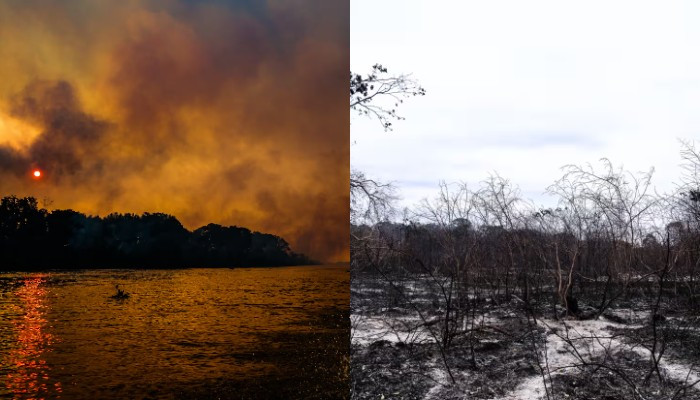Devastation as world’s biggest wetland burns: ‘those that cannot run don’t stand a chance’
 Perched atop blackened trees, howler monkeys survey the ashes around them. A flock of rheas treads, disoriented, in search of water. The skeletons of alligators lie lifeless and charred. The Pantanal, the world’s largest wetland and one of the most biodiverse places on Earth, is on fire. Huge stretches of land resemble the aftermath of a battle, with thick green shrubbery now a carpet of white ash, and chunks of debris falling from the sky. “The impact is devastating. Animals are dying, wildfires are vanishing huge areas,” says Gustavo Figueirôa, a biologist at SOS Pantanal, a non-governmental organisation. “We expect it is only going to get worse.” Stretching across Brazil, Bolivia and Paraguay, the Pantanal covers 16.9m hectares (42m acres) and harbours rich biodiversity. It is one of the world’s main refuges for jaguars and houses a host of vulnerable and endangered species, including giant river otters, giant armadillos and hyacinth macaws. Its ecosystem is also unique. Every year its “flood pulse” sees it swell with water during the rainy season and empty throughout the dry months. But the climate crisis, droughts and weak rains have disrupted this seasonal pattern, turning the land into a tinderbox. With the blazes starting unusually early this year – in late May and early June, before the annual fire season between July and September – experts predict 2024 will be the most devastating in decades. “The wildfires are a signal – nature is raising a flag,” says Pierre Girard at the Federal University of Mato Grosso. “We had fires before but now thousands and thousands of hectares burn every year. We are losing the battle.” On the banks of the Paraguay River, several hours by boat north of the nearest city of Corumbá, three children stand in their garden, their bodies intermittently concealed by smoke. Their mother, Jane Silva, 53, watches from her blue, wooden house. “This year’s fires are really bad. There is a lot of smoke and the children are struggling to breathe,” she says. Fifty of her animals died in a recent fire, and she has received no support from the state, she says. “The fires get worse every year – we thought this year’s fires had been extinguished, but the wind has brought them back to life. Now it is getting close again,” she says. “The Pantanal is dying, but we have nowhere to go.” Hospitals and health centres in Corumbá are crowded with patients suffering respiratory issues, with children under five and those over 60 most affected by the smoke. But while humans can usually flee the infernos and seek medical help, animals perish in their thousands. Reptiles and amphibians face the greatest risk, while monkeys die from smoke inhalation, and jaguars, too, have been found suffering with third-degree burns. In the 2020 fires, known as “the year of flames”, which saw almost 30% of the biome burned, 17 million vertebrates were killed. Deep into the charred wilderness, a team of volunteer animal rescue workers search for signs of life. Luka Moraes, a 26-year-old vet, says: “In one week I have already seen hundreds and hundreds of dead animals, maybe thousands. Reptiles, snakes, frogs – all the animals that cannot run – they do not stand a chance.” |

At least 22 killed in collapse of two buildings in Morocco's old city of Fez (video)
55910.12.2025, 16:24
Death toll from devastating Indonesia floods hits 950 (video)
64708.12.2025, 11:31
Radio New Zealand: Children injured after chemical detergent used on daycare waterslide (video)
86605.12.2025, 10:49
Air Force pilot safely ejects before F-16 fighter jet crashes in California desert (video)
91304.12.2025, 13:25
Marine robotics firm will resume deep-sea search for MH370 plane that vanished a decade ago
96503.12.2025, 20:24
Death toll from Indonesia's floods and landslide hits 753
88502.12.2025, 14:48
